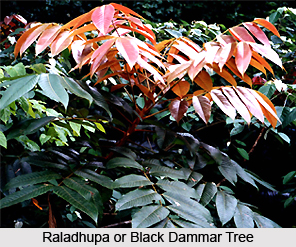 Raladhupa, an Indian medicinal plant is found in moist evergreen forests of eastern India, on the west coast in Karnataka, Kerala and in Tamilnadu. It is also found up to an altitude of 1600 m in the Western Ghats and in the Andaman Islands. Biologically this plant is known as Canarium strictum Roxb. It is commonly known as Kala Dammar in Bengali, Gujarati and in Hindi; Black Dammar-Tree in English; Mandadupa in Kannada; Karutha-Kungiliyam Telli in Malayalam; Dhup in Marathi, Mandadhupa in Sanskrit and in Tamil this medicinal plant is commonly known as Karang Kunthrikam.
Raladhupa, an Indian medicinal plant is found in moist evergreen forests of eastern India, on the west coast in Karnataka, Kerala and in Tamilnadu. It is also found up to an altitude of 1600 m in the Western Ghats and in the Andaman Islands. Biologically this plant is known as Canarium strictum Roxb. It is commonly known as Kala Dammar in Bengali, Gujarati and in Hindi; Black Dammar-Tree in English; Mandadupa in Kannada; Karutha-Kungiliyam Telli in Malayalam; Dhup in Marathi, Mandadhupa in Sanskrit and in Tamil this medicinal plant is commonly known as Karang Kunthrikam.
Raladhupa is a tall, evergreen, buttressed tree, up to 50 m tall with a straight, white, cylindrical stem. The barks are hard and light greenish-grey in colour. These are thin, rough, to some extent aromatic, exfoliating and yield black resins on cutting. Both the twigs and leaflet under-surfaces are covered with reddish hairs. The young foliage is bright yellow, which turns crimson in the later period. Leaves of these trees are alternate, large, usually of 0.6-1.2 m long.
The leaflets are 7-15 in number, opposite or alternate, ovate-oblong which are10-20 cm long as well as 4-10 cm wide. Flowers of this tree are small, white or bright yellow, and slightly fragrant. The male and female flowers can be distinguished clearly; pedicels are short; calyx usually of 4-lobed; petals 6 mm long and 2 mm broad and apex are rounded. The fruits are ellipsoid and up to 3.8-5 cm long, resinous with a hard stone.
Raladhupa trees play a major role in the Indian medicines. The resin of this tree possesses some important medicinal properties. It is used in treating chronic skin diseases such as psoriasis and pityriasis. It is used as an ointment with sesame oil to ease the rheumatic pains. The resin of this medicinal plant is also used as a decoction or in powdered form for the treatment of fever, cough, epilepsy and asthma.
Apart from the medicinal properties, this tree is useful for some other purposes. The bark of Raladhupa tree yields an aromatic resin, known commercially as black dammar, which is used as an incense and illuminant. It is mixed with fish oil, and used for caulking boats and preserving fishing lines. When it is dissolved in turpentine, it makes a good, dark-coloured varnish.



















